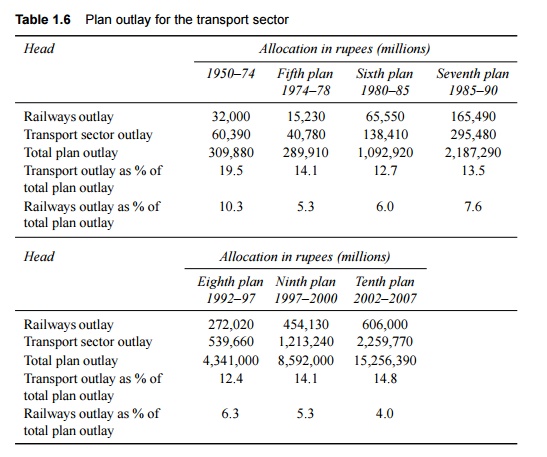Chapter: Civil : Railway Airport Harbour Engineering : Railway Engineering : History and General Features of Indian Railways
Long term Corporate Plan of Indian Railways
Long-term Corporate Plan of Indian
Railways
The Railways has a
crucial role in the planned economic development of the country. In an
environment of rapid technological changes, faster economic growth, and
enhanced expectations of people, a long-term perspective of railway development
is vital. A corporate plan provides this perspective, and spells out the
objectives to be achieved and the strategies to be followed.
The first corporate
plan of Indian Railways, covering a period of 15 years up to 1988-89, was
published in 1976. Subsequently, a fresh corporate plan for the period
1985-2000 was prepared, which had envisaged an investment of about Rs 461,700
million in the railways system up to 2000 AD.
A new corporate plan
for the period 2001-2012 has been prepared recently by Indian Railways. Some of
the salient features of the new corporate plan are as following:
(a)Core
value Customer above everything else; valuing the customer
and providing them safety, security, punctuality, and reliability.
(b) Core
purpose To provide cost-effective rail and integrated
intermodal/ multimodal transportation/logistics services with
state-of-the-art, eco-friendly technology (including information technology)
while maintaining the financial viability of the system.
(c) The
annual fund requirement for the corporate plan at 2000-2001 prices is estimated
at about Rs 170,000 million.
1.Strengths of Indian
Railways
The following are the strengths of the Indian
Railways system.
(a) For
a vast country with great distances and a large population, the railways have
an inherent advantage over other modes of transport in their suitability for
movement of large volumes of passenger and goods traffic over long distances.
(b) The
movement of steel wheels on steel rails in the railway system has the basic
advantage of low rolling resistance, which reduces energy requirements and
haulage costs.
(c) Railways
are more efficient than roadways in terms of land use.
(d) Railways
are an energy-efficient mode of transport, particularly for freight traffic,
and can use different forms of energy. Railways also cause relatively less
environmental pollution than roadways.
(e) In
densely populated urban centres, a rapid transit rail-based system is the most
appropriate mode of transport for suburban intra-urban travel, as part of a
city's integrated transport system.
Indian
Railways is a well-established organization with a large pool of skilled and
trained personnel.
(g) Being
part of the Central Government, Indian Railways has the Government's financial
backing. At the same time, they have considerable financial autonomy.
(h) Indian
Railways is a self-reliant system with respect to its major equipment needs.
2
Weaknesses of Indian Railways
The
following are the weaknesses of the Indian Railways system.
(a) A
large portion of the railway's infrastructure is overaged, and in urgent need
of replacement or rehabilitation. This includes track, motive power and rolling
stock, signalling, operational, and maintenance equipment.
(b) In
certain parts of the infrastructure, the technology is 20-25 years behind some
of the developed railway systems. Consequently the productivity levels are
comparatively low.
(c) Indian
Railways has a large force of unskilled manpower. The training facilities need
augmentation and modernization.
(d) A
persistent resource constraint in the past has adversely affected the Railways'
development.
(e) Indian
Railways carries a substantial 'social burden' in the form of continued
operation of un-remunerative branch lines, subsidies on passenger and suburban
travel, and even freight subsidy on certain commodities.
(f) In
certain areas, pilferage and vandalism seriously affect operational efficiency.
(g) Railways
are not suited for carriage of small quantities of freight particularly over
short distances.
(h) Heavy
investments are needed to build up railway transport capacity and the gestation
periods are long.
(i) Transport
capacity is volatile and cannot be recouped if not utilized continuously.
3.Planning
Strategy
The development plans of Indian Railways have been
drawn up within the framework of the national five year plans. Plan outlays of
Indian Railways as well as those for the transport sector as a whole are shown
in Table 1.6.
Tenth
Five Year Plan (2002-2007)
The
objectives of the tenth Five Year Plan are the following:
(a) Strengthening
high-density networks-Investments towards building up capacity through National
Rail Vikas Yojana for national projects and towards the completion of
sanctioned rail projects.
(b) Technologically
upgrading assets for improving efficiency, output, and the average speed of
trains.
(c) Utilizing
information technology for creating better customer interfaces.
(d) Improving
the safety of operations by replacing overaged assets using the special railway
safety fund.
(e) Rationalizing
fund allocation to rail projects.
(f) Reducing
energy expenditure by direct purchase of power from central generating agencies
and by setting up power plants through joint ventures.
(g) Mobilizing
additional resources through private/public participation in railway projects.
(h) Increasing
freight and passenger traffic during the term of the plan.

Related Topics